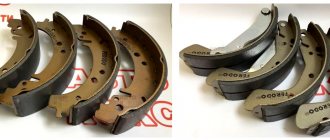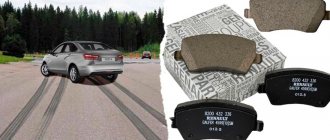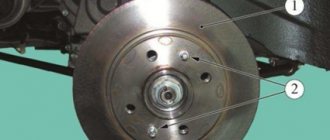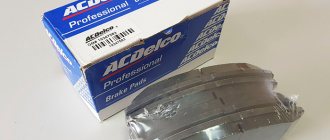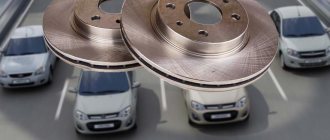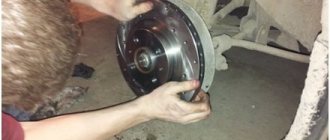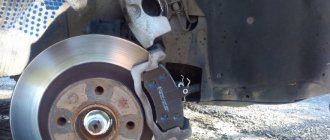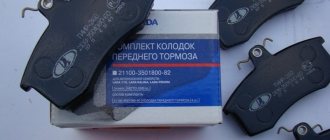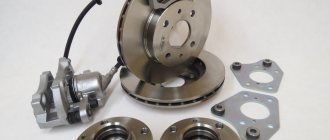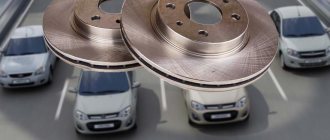Drum brakes are still used in the automotive industry, so the best manufacturers are trying to release new models with improved technical characteristics. The braking efficiency will depend on the quality of the purchased products, so it is important to know how to choose the appropriate options not only in terms of price, but also in terms of technical features. In the article we will look at recommendations for choosing, what new and popular models are on the market, and what mistakes you can make when choosing.
Description
Brake drums were designed back in the 19th century. At the beginning of the 20th century, the design underwent significant changes. This device also functions as a hand brake. Drum brakes compare favorably with disc brakes not only in terms of savings in production, but also in greater efficiency and longer service life.
Design
The following elements are found inside:
- brake pads (each manufacturer has its own composition, they keep it secret);
- one or more hydraulic cylinders;
- protective disk;
- retainer;
- tension springs;
- hairpins;
- self-feeding mechanism;
- block spacer;
- pad supply mechanism.
Principle of operation
When you press the brake pedal, pressure occurs in the working fluid system. It acts on the piston of the brake cylinder, the latter element actuates the brake shoe, which is located on the sides and is in close contact with the drum. Accordingly, the speed of rotation of the part decreases and due to this the speed of the car decreases. Modern technologies provide the fastest possible braking, regardless of the condition of the road surface.
Pros:
- inexpensive to manufacture, much cheaper than disk options;
- the resource is 30-40% greater than that of disk drives;
- less often have to be changed.
Minuses:
- brakes worse compared to disc ones;
- become dirty inside.
So which is better?
What to choose in the end so as not to make a mistake? Guys, I’ll say that very few people now change aluminum to cast iron in drums or vice versa, most likely the replacement will be with disc brakes (they are really better), and ventilated or even perforated , it has been proven that with these the car brakes 15 - 20% more efficiently.
And the choice between these two, I personally would fall on cast iron, but it needs to be tinted, and it’s heavier, a pair is about 8-10 kilograms, but it’s more reliable and easier to remove. This is my personal opinion.
I’ll end here, read our AUTOBLOG
(
17 votes, average: 4.18 out of 5)
Similar news
Brake fluid composition. Basic properties, necessary information
What is and how does a brake caliper work? Let's look at the main problem.
How and with what paint to paint the brake drums. So as not to rust.
Source
Kinds
Let's consider the types depending on the installation location:
- Front. Installed on the front axle.
- Rear. Installed on the rear axle.
Let's consider what types of brake drums there are depending on the material of manufacture:
- Aluminum. They are more popular, they are lighter than cast iron, cost a little less, heat up poorly and cool down quickly, which is an important factor in the operation of the braking system. It practically does not suffer from corrosion and has a more presentable appearance. The disadvantages include rapid wear, they are fragile, difficult to remove, they “stick” to the surface.
- Cast iron. Several times heavier than aluminum, but much stronger. They do not stick so much and do not deform under temperature overloads. Less effective in braking, heavy.
Aluminum
It would seem that a more modern and advanced material should have become a very successful competitor to traditional cast iron. Its undoubted advantages include:
- Price. Nobody likes to overpay, and our people in particular. Aluminum drums cost about 2 times cheaper;
- Low wear resistance. You will have to change the drums quite often, which, in fact, you would like to avoid in the first place;
- Intolerance to temperature changes. So if, for example, you drive into a puddle on hot drums, expect problems;
- Aluminum drums stick tightly. To remove them, in most cases you won’t be able to use a regular sledgehammer. And you will have to change it often (see point 1), that is, the problem increases exponentially.
- Aluminum does not hold geometry well - the metal is still soft. So they will have to be edited regularly, which makes no one happy.
But the worst thing is the very limited choice of manufacturers and the huge percentage of defective products. People who fell for the price and ease happened to return substandard items back to the sellers with corresponding unflattering reviews. There is an opinion among drivers that if high-quality (read: imported) aluminum were available, they would put up with some of its shortcomings.
The best manufacturers
Let's consider the most recognizable and reliable manufacturers:
- AUTOREAL. The manufacturer guarantees that braking will be smooth and the pads will not knock during operation. It is the first Russian company to produce lightweight cast iron brake drums. The product is resistant to deformation, has a long service life and there is no vibration during operation. Of the minuses, it can be noted that cast iron (even lightweight) options are heavier than aluminum counterparts.
- ZEKKERT. An actively developing Chinese company, the official office is located in Germany. The main difference in the market is that they provide an optimal price-quality ratio for their products. Their products have high quality raw materials, a pleasant appearance, but at the same time there are deformed parts.
- PILENGA. A fairly large company, its production facilities are located in Japan, Italy, Europe, America, and Asia. More than 35% of products are brake systems. Precise geometry and high quality alloy guarantee trouble-free operation in all weather conditions. The product has a long service life, there is no vibration in operation, and high-quality braking is ensured. However, the parts are susceptible to corrosion.
- TRW. The company's products occupy almost 50% of the European automobile market. Innovative developments have made it possible to create a series of products with quiet and smooth operation. The components have a good service life, provide smooth braking in any weather and operate quite quietly. However, fakes are very common.
- AND THOSE. Part of a large German concern. The regulated service life of spare parts is 130,000 km. The products have a long service life, brake effectively, and in some modifications there is an anti-corrosion coating. The downside is the expensive cost.
Battery VAZ / Bogdan / 2110 / 2111 / 2112
Standard battery
A battery is installed on the Priora from the assembly line; this battery production company has proven itself well in the market. The products of this company, when used correctly, easily overcome the milestone of 5 years of active work.
Characteristics of a standard battery
| Name | Parameter |
| Manufacturer | AKOM (Russia) |
| Voltage (V) | 12 V |
| Starting current (A) | 510 A |
| Capacity (Ah) | 60 Ah |
| Cost, rub) | 3000 rub |
Starting current
An important parameter is the starting current. This characteristic refers to the amount of energy that the battery can supply at one time. From the factory, cars of the brand in question are equipped with a battery with a rating of 425 A. This figure is small; such a battery cannot have a good stable start in cold weather.
The optimal solution is to install a battery with a starting current of 450 A or more. This parameter does not affect charging or operation in any way. The only drawback is the relatively high cost. Separately, you need to dwell on the manufacturer. The optimal solution would be to purchase:
- Multu,
- Varta.
The first is resistant to self-discharge at low temperatures. It will be possible to start the engine even at -400 C. Its only disadvantage is its relatively high cost. Varta will be somewhat cheaper. The battery is also expensive, but slightly cheaper than the Multu. When choosing, you need to focus primarily on the equipment parameters.
Reasons for battery failure
There can be many reasons for battery failure. Below is a list of reasons:
- Overcharge. Occurs due to a faulty car generator.
- Overheat. Most often it occurs in hot summer months; the temperature of the electrolyte exceeds the permissible values, which leads to damage to the battery plates.
- Low voltage in the car network. Occurs due to a malfunction in the generator.
- The battery is completely discharged. Occurs due to a broken alternator belt or when the side lights are on and the engine is off.
- Freezing. Occurs in winter if the battery is left in the cold for a long time.
TREASURE IN THE GARAGE
V. Krivosheev, Samara
The reason for sending advice was a story about resource tests of editorial Largus. It mentioned that the front stabilizer mounting bolts were badly damaged by corrosion. For about thirty years now, I have been using a proven product - Movil - to protect threaded connections, including when repairing suspension. Fasteners treated with it can be unscrewed freely even after many years. The shelf life of this drug is almost unlimited. Even slightly thickened, it also reliably protects the fasteners. There is only one drawback: if it gets on your hands, you cannot remove it without a solvent.
Battery light is on
On the dashboard of the Lada Priora there are a large number of different indicators indicating any malfunctions or the state of the engine. Quite often it happens that a red lamp with a picture of a battery may light up on the dashboard.
Criterias of choice
Tips on what to look for when choosing:
- Material. If you plan to lighten the weight of the car and the load on the rear axle, then choose an aluminum drum, but if you need durability and reliability, opt for the cast iron option.
- Which company is better? When choosing, the model and make of the car are important; brake drums from domestic and foreign companies have the same functionality, so when choosing which one is best to buy, focus on your needs and capabilities.
- What is the price. Cost will vary depending on brand recognition, delivery and material of manufacture. On average, the price range ranges from 500 rubles to 8,500 rubles. Budget models will be less durable and more efficient, but you shouldn’t overpay just for the brand either.
- Reliability. Be sure to check the compliance of the purchased product with international quality standards. Regardless of where you purchase, ask the seller for all the necessary documents and certificates. It is also important that all products pass all necessary tests for balancing, weight, geometry, static stiffness, heating behavior, etc. Your health and your life depend on the reliability and efficiency of the system.
- Original. Try to purchase original spare parts for your car; cheap counterfeits (analogs) may not fit the technical parameters, or have low performance, and may not do the job, then you will overpay for a repeat purchase.
Cast iron
The disadvantages of this material are directly opposite to the advantages of aluminum. That is, cast iron drums are heavy, expensive and rust, so they need to be painted and treated with anti-rust. However, their reliability is beyond praise: they are temperature stable (the handbrake does not stick even in deadly frosts), they do not creak, something that aluminum often suffers from, their geometry is correct from the moment of purchase and does not require adjustments throughout their service life. True, you will need to buy stronger pads for them - soft ones will quickly wear out.
Another advantage is that they practically do not stick.
: Cast iron drums that have been in service for years often do not even require the use of a sledgehammer.
As for going overboard with weight, this argument is somewhat dubious: in aluminum drums, the working surface is also filled with cast iron, that is, the gain in lightness is not so great.
An additional bonus is the ability to choose a manufacturer: cast iron drums are produced by many firms and companies.
Rating of quality brake drums for 2022
The rating includes the best models, according to buyers. The popularity of the models, their reviews and consumer reviews were taken as a basis. The rating was divided into 2 large groups: domestic manufacturers and foreign manufacturers.
Models from a foreign manufacturer
BM-MOTORSPORT DR6035 cast iron, 203 mm
High quality products are achieved through the use of modern production technologies and innovative equipment. The part has high resistance to wear and overheating, and a long service life. Average price: 1701 rub.
BM-MOTORSPORT DR6035 cast iron, 203 mm
Advantages:
- quality material;
- trusted manufacturer;
- durability.
Flaws:
- not identified.
| Characteristics | Description |
| Drum material | cast iron |
| Hole Diameter (mm) | 203 |
| Bridge installation | rear |
| Drum weight (kg) | 11.96 |
BAPCO BDR0087
The product has all the necessary quality certificates. The manufacturer's warranty is 2 years; the company ensures exact fit (compatibility) of the part. Installation axle: rear. Average cost: 1560 rub.
BAPCO BDR0087
Advantages:
- 100% applicability (compatibility);
- ease of installation;
- optimal price.
Flaws:
- not identified.
| Characteristics | Description |
| Drum material | cast iron |
| Quantity (pcs) | 1 |
| Dimensions (m) | 0.33x0.32x0.095 |
| Drum weight (kg) | 7.745 |
OTAKA ABS for 1 bearing
Brake drum for 1 bearing. Good maintainability, long service life at an optimal price, make this manufacturer stand out on the market. Average price: 960 rub.
OTAKA ABS for 1 bearing
Advantages:
- good maintainability;
- simplicity of configuration;
- high build quality.
Flaws:
- not identified.
| Characteristics | Description |
| Applicability | OTAKA |
| Quantity (pcs) | 1 |
| Drum weight (kg) | 3.75 |
TRIALLI TF015132 /76187 2 000
The cast iron drum of a well-known international company has high wear resistance and resistance to overheating. Installed on the rear axle. The diameter of the central hole is 52. The inner diameter of the drum is 203 mm, the outer diameter of the drum is 234 mm. Average cost: 1710 rub.
TRIALLI TF015132 /76187 2 000
Advantages:
- optimal price-quality ratio;
- innovative production technologies;
- durability.
Flaws:
- without bearings and ABS rings.
| Characteristics | Description |
| Manufacturer | TRIALLI |
| Parameters (mm) | 204.5x50.5 |
| Number of holes (pcs) | 4 |
| Maximum drum bore diameter | 204.5 |
| Internal height | 50.5 |
| Overall height | 76 |
| Drum weight (kg) | 11.966 |
BLITZ BT0137
The company is part of Carberry and specializes in the production of spare parts for the brake system. The packaging not only looks presentable, but also contains all the necessary detailed information. Anti-squeak plates are included. Average price: 2286 rub.
BLITZ BT0137
Advantages:
- detailed instructions for use;
- durability;
- verified manufacturer.
Flaws:
- difficult to find on the market.
| Characteristics | Description |
| Manufacturer | BLITZ; Germany |
| Parameters (mm) | 207.9x65.7 |
| Number of holes (pcs) | 4 |
| Drum weight (kg) | 6.54 |
AC Delco 19372219
An American company with a long history of development, it uses its own innovative developments and advanced technologies to produce high-quality products at low costs. They produce spare parts for both trucks and cars. Average cost: 3184 rub.
AC Delco 19372219
Advantages:
- long warranty from the manufacturer;
- innovative manufacturing technologies;
- availability.
Flaws:
- not identified.
| Characteristics | Description |
| Manufacturer | ACDELCO |
| Weight, kg) | 4.4 |
| Type of equipment | cars |
| Installation side | rear axle |
HERTH-BUSS J3401030
The model's hub diameter is 52 mm, height 76 mm, diameter 203.3 mm. Manufacturer from Germany. The company guarantees the high quality of raw materials and the durability of its products. Compatible with cars: NISSAN MARCH III, NISSAN MICRA C+C, NISSAN MICRA III, NISSAN NOTE, etc. Cost: 5508 rub.
HERTH-BUSS J3401030
Advantages:
- perfect compatibility with NISSAN cars;
- long service life;
- quality raw materials.
Flaws:
- not identified.
| Characteristics | Description |
| Manufacturer | HERTH-BUSS |
| Drum diameter | 203.3 |
| Number of holes | 4 |
| Chamfer diameter (mm) | 100 |
JAPANPARTS TA600
Drum with 4 holes, internal height 34 mm. The model can be used on various cars; applicability and compliance can be clarified on the website in the manufacturer’s catalog. High resistance to overheating guarantees optimal performance in all weather conditions. Cost: 2942 rub.
JAPANPARTS TA600
Advantages:
- wide application;
- resistance to overheating;
- reliable brand.
Flaws:
- difficult to find in stores.
| Indicators | Meaning |
| Drum inner diameter (mm) | 165 |
| Bridge installation | rear |
| Hub Bore Diameter (mm) | 51.7 |
METACO 3070026
METASO is a dynamically developing company with 25 years of experience in the production of automotive parts. All products undergo mandatory testing to ensure compliance with international quality standards. Manufacturer's warranty up to 3 years. Cost: 2990 rub.
METACO 3070026
Advantages:
- production is constantly being improved;
- great guarantee;
- reliable.
Flaws:
- price.
| Indicators | Meaning |
| Applicability to cars | Mitsubishi, Smart |
| Bridge installation | rear |
| Brand | METACO |
From a domestic manufacturer
ATS 1118
The ATS company is one of the first domestic companies that was one of the first to master the production of spare parts for cars. Cast iron is less susceptible to overheating and deformation than its aluminum counterpart. Warranty from the manufacturer 2 years. Average price: 1550 rub.
ATS 1118
Advantages:
- light weight;
- high manufacturing precision;
- less susceptible to overheating.
Flaws:
- not identified.
| Indicators | Meaning |
| Material | pearlitic cast iron |
| Set (pcs) | 2 |
| Dimensions (cm) | 24x24x13 |
| Drum weight (kg) | 7 |
BULAT 2105
Lightweight and reliable drum, ideally compatible with AvtoVAZ vehicles. Manufactured by injection molding followed by processing. Price: 1027 rub.
BULAT 2105
Advantages:
- provides more reliable braking compared to analogues;
- high quality material;
- ease of installation.
Flaws:
- not identified.
| Indicators | Meaning |
| Material | Aluminium alloy; cast iron |
| Set (pcs) | 1 |
Remoff G 3302
Made of high-strength cast, mounted on the rear axle. Designed for the rear axle braking system of GAZelle trucks and all modifications. Cost: 1968 rub.
Remoff G 3302
Advantages:
- reliable manufacturer;
- availability;
- easy installation.
Flaws:
- Some parts require sharpening on a lathe.
| Indicators | Meaning |
| Material | high strength cast |
| Dimensions (diameter and height) (cm) | 32x12 |
| Weight (kg) | 13 |
| Manufacturer | REMOFF |
PAZ 3204 front/rear (brake tilt 160 mm)
Products from a domestic manufacturer have all the necessary certificates of conformity. The set includes 1 piece. This model can be ordered online in an online store, or purchased at an automobile store in your city. Average cost: 8262 rub.
PAZ 3204 front/rear (brake tilt 160 mm)
Advantages:
- availability;
- wear resistance;
- resistance to overheating.
Flaws:
- price.
| Indicators | Meaning |
| Number of holes (pcs) | 6 |
| Dimensions (diameter and height) (cm) | 42x2 |
| Weight (kg) | 14.6 |
| Manufacturer | KAAZ |
Lumen and cast iron
SAMARA BRAKE DRUMS - ALUMINUM OR CAST IRON?
Bearded army jokes about “the lightest iron in the world” came to mind with the appearance of cast iron brake drums for Samara on sale. We have been familiar with “lumen” for a long time, but “cast iron” is a dark horse. Let's compare?
Products from Engels were entrusted to defend the interests of “ordinary” aluminum drums with cast iron inserts - they have proven themselves well. The “pure cast iron” colleagues arrived from the ATE company from Germany. Each side was represented by two reels - the rivals' business cards are shown below.
During the tests, they decided to check the geometry of the drums, measure their mass, evaluate static balancing, and also study the behavior of the products when heated and determine their static rigidity. As usual, this work was carried out by NAMI specialists.
The fact that “cast iron” would be heavier than “lumen” was clear without any weighing - but by how much? It turned out that it was approximately doubled - the mass of Russian drums was 2420 and 2460 g, respectively, and German ones - 5020 g each. Heavy, but absolutely identical!
There is more fuss with the geometry - exemplary dimensions are shown in Fig. 1. The drums were first measured in their original state, then tested with heating cycles, after which the measurement was repeated. The results are in the table. There is also data on the static imbalance of the drums.
The heating dynamics of brake pads working in tandem with our drums were determined as follows. The experimental drum was installed on an inertial stand and 15 cycles of successive braking were carried out in the speed range from 120 to 60 km/h at a pressure in the stand drive of 50 kgf/cm2 with an interval of 45 s. What happened with sequential temperature measurements is clearly depicted in Fig. 2.
Each of the graphs shown is based on the average heating results of two drums of both types. It is easy to see that the difference in the heating dynamics of aluminum and cast iron products is insignificant: after the 15th braking, the “lumen” gained only five extra degrees - this fits into the measurement error.
Difficulties during assembly
Let's return to dismantling the brake mechanism. It may happen that as a result of wear, a shoulder forms on the inner surface of the brake drum, which will prevent dismantling. The drum will still have to be removed, and after that it is necessary to measure its internal diameter. Acceptable dimensions for VAZ 2108 are 200-201.5 mm. If the diameter is larger, the drum must be replaced. If the size is within the acceptable range, then in order to remove the collar, it is enough to arm yourself with a file, install the drum on the front hub with the working surface facing outward, start the engine and engage first gear.
The drum will rotate, and using a file and sandpaper it is easy to level the bead with the work surface. After this, you need to achieve a smooth surface without marks or burrs, but after grinding it is worth measuring the inner diameter of the drum again. If the diameter is larger than normal, then there is a possibility of loss of strength, so it is better not to take risks.
In general terms, this is all you need to know about the VAZ 2108 drum brakes in order for them to provide reliable braking.
Which rear pads to choose for replacement?
On average, rear brake pads last from 30 to 50 thousand km. However, their service life depends primarily on the driving style and the quality of the pads themselves. It is clear that cheaper ones will wear out faster. That is why you should not buy too cheap analogues.
I recommend periodically - once every 15-20 thousand km. mileage to carry out diagnostics of the brake system. Check the brake fluid level and the condition of the pads themselves. If the thickness of the working surface of the pad is 2 mm or less, they should be replaced. The pads are replaced in pairs. That is, 4 pieces at once - on the front or rear wheels.
Original Hyundai/KIA 58302 1RA30 pads were installed from the factory. The cost of the kit at the moment is from 2000 rubles. However, in addition to the original, you can also choose cheaper analogues of quite good quality.
- Allied Nippon ADB32023 from 880 rub.
- Avantech AV202 from 1000 rub.
- Bosch 0 986 494 557 from 11,000 rub.
- Ferodo FDB4387W from 1100 rub.
- Frixa FPH17R from 1350 rub.
- LYNXauto BD3620 from 850 rub.
- Sangsin Brake GP1401 from 1250 rub.
- SCT Germany SP629 from 750 rub.
What tools are needed to replace pads?
Replacing pads is a simple operation, so there is nothing exotic in the set of tools and materials. All you need is:
- Knitted gloves and rags.
- Car jack.
- Wheel chocks.
- Wheel wrench (balloon).
- Keys for 17 open-end, and for 14 cap.
- Slotted screwdriver.
- Soft brush for metal.
- Adjustable pliers or extendable pliers, with a grip of up to 60 mm.
- A bulb for collecting excess brake fluid.
- 50 cm of wire or cord.
- Lubricant for guide bolts.
Pliers or pliers are needed to press the brake piston into the cylinder. A tool is not needed every day. Therefore, you don’t have to buy it specifically. You can drown the piston in another way.
Lumen and cast iron
LUMEN AND CAST IRON
SAMARA BRAKE DRUMS - ALUMINUM OR CAST IRON?
Bearded army jokes about “the lightest iron in the world” came to mind with the appearance of cast iron brake drums for Samara on sale. We have been familiar with “lumen” for a long time, but “cast iron” is a dark horse. Let's compare?
Products from Engels were entrusted to defend the interests of “ordinary” aluminum drums with cast iron inserts - they have proven themselves well. The “pure cast iron” colleagues arrived from the ATE company from Germany. Each side was represented by two reels - the rivals' business cards are shown below.
During the tests, they decided to check the geometry of the drums, measure their mass, evaluate static balancing, and also study the behavior of the products when heated and determine their static rigidity. As usual, this work was carried out by NAMI specialists.
The fact that “cast iron” would be heavier than “lumen” was clear without any weighing - but by how much? It turned out that it was approximately doubled - the mass of Russian drums was 2420 and 2460 g, respectively, and German ones - 5020 g each. Heavy, but absolutely identical!
There is more fuss with the geometry - exemplary dimensions are shown in Fig. 1. The drums were first measured in their original state, then tested with heating cycles, after which the measurement was repeated. The results are in the table. There is also data on the static imbalance of the drums.
The heating dynamics of brake pads working in tandem with our drums were determined as follows. The experimental drum was installed on an inertial stand and 15 cycles of successive braking were carried out in the speed range from 120 to 60 km/h at a pressure in the stand drive of 50 kgf/cm2 with an interval of 45 s. What happened with sequential temperature measurements is clearly depicted in Fig. 2.
Each of the graphs shown is based on the average heating results of two drums of both types. It is easy to see that the difference in the heating dynamics of aluminum and cast iron products is insignificant: after the 15th braking, the “lumen” gained only five extra degrees - this fits into the measurement error.
To evaluate the effect of temperature on the deformation of brake drums, four more heating cycles were carried out with similar braking parameters, reaching 250°C. After each such cycle, the drum was cooled to room temperature and only then measurements were continued. Dimensions B and D, which are affected by temperature, are also listed in the table. Note that the geometry of the drums remained virtually unchanged after heating - some difference in the “before and after” results does not exceed the acceptable error limits. But the static imbalance was frankly upsetting: the excellent results of the “usual” aluminum drums looked somehow impolite against the backdrop of the outright failure of the foreign guests. Of course, everything can be balanced, but where is the vaunted German pedantry, accuracy and other advantages?
The static stiffness of the drums was determined as follows. A VAZ 2108 brake mechanism was installed in the brake drum, and “brake fluid” was supplied to its brake wheel cylinder under pressure - first 10 kgf/cm2, and then 100 kgf/cm2. It is clear that in the second case, the cylinder pistons moved away from each other by a greater amount, since as the pressure increases, the drum deforms more. And if so, then more liquid would fit in the cylinder - all that remained was to measure this difference. This was done: the result was 11% in favor of “cast iron”.
Results
But everyone has their own final opinion on which brake drums are better, cast iron or aluminum. Many believe that there is no difference at all, although 8 kilograms in weight and half the price somehow do not fit into the concept of no difference. Some people suggest not taking the cheapest aluminum - they say you won’t encounter most problems, but the average one is quite good for the price. And there are people who are sure that the choice between cast iron and aluminum is not necessary at all, since the coolest of all are disc drums, for which they need to save money.
Design features
Many modern and not so modern cars and trucks, such as Kamaz (a very popular truck) or Gazelle, often have a rear braking system. It consists directly of the brake drum itself, as well as the so-called pad routing mechanism.
Moreover, in such a system it is the car brake drum that is the key component. The process of stopping the vehicle is realized due to the fact that contact between the drum and the pads begins when the driver presses the corresponding pedal. This activates the process of mutual friction, thereby reducing the speed and finally stopping the car. Drum mechanisms are usually based on high-strength cast iron.
Source
Stories from our readers
“Fucking basin. "
Hi all! My name is Mikhail, now I’ll tell you a story about how I managed to exchange my two-wheeler for a 2010 Camry. It all started with the fact that I began to be wildly irritated by the breakdowns of the two-wheeler, it seemed like nothing serious was broken, but damn it, there were so many little things that really started to irritate me. This is where the idea arose that it was time to change the car to a foreign car. The choice fell on the melting Camry of the tenth years.
Yes, I had matured morally, but financially I just couldn’t handle it. I’ll say right away that I am against loans and taking a car, especially not a new one, on credit is unreasonable. My salary is 24k a month, so collecting 600-700 thousand is almost impossible for me. I started looking for different ways to make money on the Internet. You can’t imagine how many scams there are, what I haven’t tried: sports betting, network marketing, and even the volcano casino, where I successfully lost about 10 thousand ((The only direction in which it seemed to me that I could make money was currency trading on the stock exchange, they call it Forex. But when I started delving into it, I realized that it was very difficult for me. I continued to dig further and came across binary options. The essence is the same as in Forex, but it’s much easier to understand. I started reading forums, studying trading strategies. I tried it on a demo account, then opened a real account. To be honest, I didn’t manage to start earning money right away, until I understood all the mechanics of options, I lost about 3,000 rubles, but as it turned out, it was a precious experience. Now I earn 5-7 thousand rubles a day. I managed to get the car buy after half a year, but in my opinion this is a good result, and it’s not about the car, my life has changed, I naturally quit my job, I have more free time for myself and my family. You’ll laugh, but I work directly on the phone)) If If you want to change your life like me, then here’s what I advise you to do right now: 1. Register on the site 2. Practice on a Demo account (it’s free). 3. As soon as you get something on the Demo account, top up your REAL ACCOUNT and go to REAL MONEY! I also advise you to download the application to your phone, it’s much more convenient to work from your phone. Download here.
